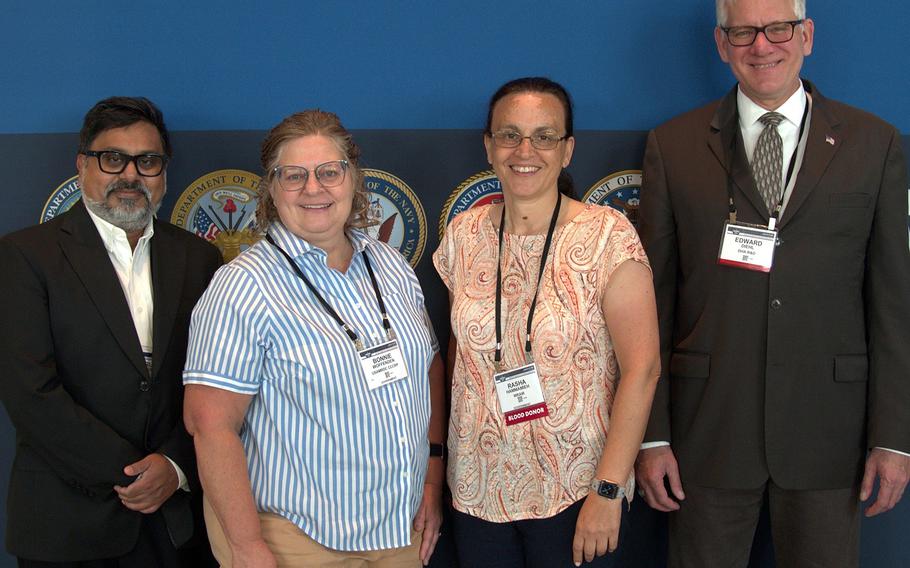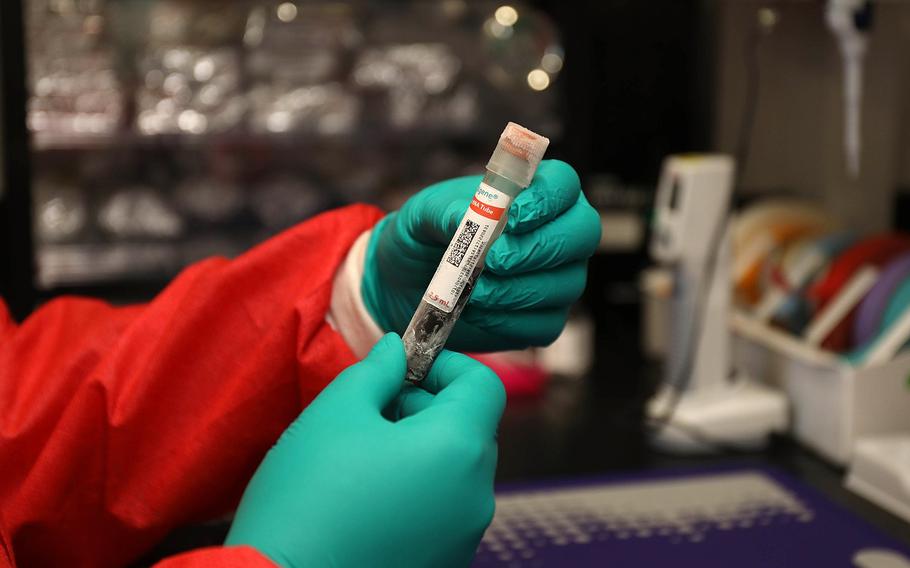
Rasha Hammamieh, second from right, and Nabarun Chakraborty, left, of the Walter Reed Army Institute of Research, invented a new medical device that uses an artificial intelligence machine learning algorithm to predict whether burn patients are at risk of developing life-threatening sepsis. (Paul Lagasse/U.S. Army)
Army researchers say they now can predict sepsis in burn patients thanks to a system that analyzes blood using common hospital equipment and an artificial intelligence machine learning algorithm.
SeptiBurnAlert, developed by scientists at the Walter Reed Army Institute of Research in Maryland, uses a machine to check a patient’s blood for biomolecular changes associated with the onset of sepsis, a potentially fatal condition where the body responds improperly to infection. The AI algorithm then uses the data to calculate risk.
“The beauty of this is the very early prediction of sepsis, and again that’s days before onset of sepsis,” researcher Rasha Hammamieh said. “This is not only for the warfighter. For all burn patients, this can be a useful tool.”
The research team has applied for a worldwide patent and submitted the invention in August to the Food and Drug Administration for initial guidance review with the hopes of bringing it to the commercial market in about three years. The FDA should respond within 70 days.
In initial tests, the system has predicted risk within the first 24 hours of hospitalization, down from over 72, with an 85% to 90% degree of accuracy, researcher Nabarun Chakraborty said last month.
Burn injuries are becoming increasingly common on modern battlefields, partly due to improvised explosive devices, a Defense Department epidemiology study from July said.
Over 2,500 U.S. service members sustained burn injuries between 2001 and 2018 in Iraq and Afghanistan. Bacteria, one of the leading causes of infection, was often reported.
When sepsis occurs, the body responds with a series of symptoms including clammy or sweaty skin, fever, confusion, shortness of breath and extreme pain or discomfort, according to the U.S. Centers for Disease Control and Prevention. Sepsis shouldn’t be confused with septic shock, a life-threatening complication of sepsis that occurs due to extremely low blood pressure.

A laboratory technician at the Walter Reed Army Institute of Research in Silver Spring, Md., prepares a blood sample collected from a burn patient for analysis in this undated photo. (Walter Reed Army Institute of Research)
Approximately 30% of burn patients experience sepsis, which kills approximately 350,000 adults in the U.S. each year, the CDC said. A 19-year-old Air Force Academy cadet died last month from sepsis that complicated a respiratory infection.
Hammamieh and Chakraborty got the idea for SeptiBurnAlert a decade ago while attempting to identify biomarkers related to clotting and trauma.
They saw burn patients they were monitoring develop sepsis and wondered whether researchers could use the data to predict who was susceptible.
In the years that followed, they identified changes in specific genes, proteins and metabolites and tweaked their algorithm. They tested their model with samples from 15 patients from the burn unit at MedStar Washington Hospital Center, Chakraborty said.
There are three FDA-approved tests for specific biomolecular changes in existence, but all are for the critically ill. None of them look for burn sepsis.
The researchers are working with various companies to produce a handheld device. Studies by university business schools have shown strong interest for the system in the medical community, said Edward Diehl, medical technology transfer office commercialization officer with the U.S. Army Medical Research and Development Command.
Proceeds from eventual sales would be split between the laboratory at the Institute of Research, the inventors, Army headquarters and the transfer office.